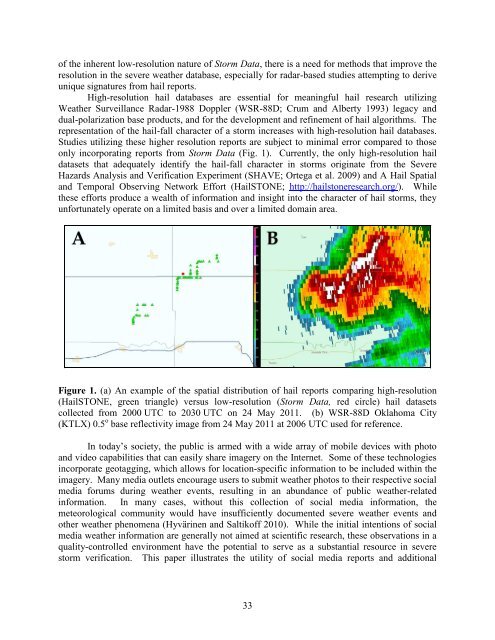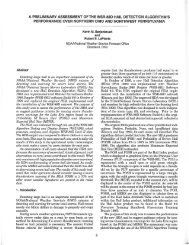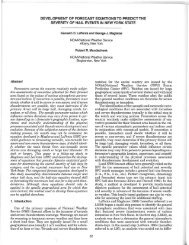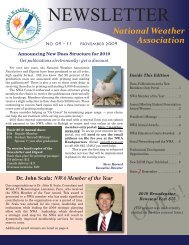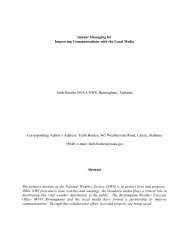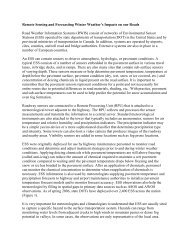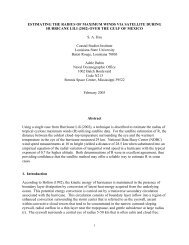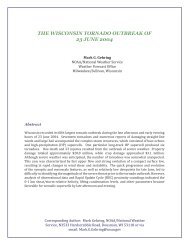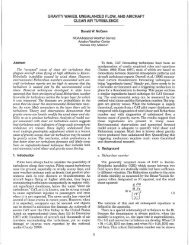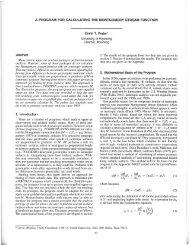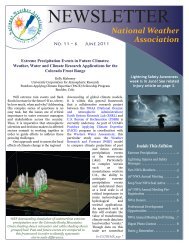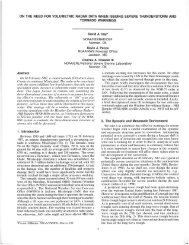Creating high-resolution hail datasets using social media and post ...
Creating high-resolution hail datasets using social media and post ...
Creating high-resolution hail datasets using social media and post ...
You also want an ePaper? Increase the reach of your titles
YUMPU automatically turns print PDFs into web optimized ePapers that Google loves.
of the inherent low-<strong>resolution</strong> nature of Storm Data, there is a need for methods that improve the<br />
<strong>resolution</strong> in the severe weather database, especially for radar-based studies attempting to derive<br />
unique signatures from <strong>hail</strong> reports.<br />
High-<strong>resolution</strong> <strong>hail</strong> databases are essential for meaningful <strong>hail</strong> research utilizing<br />
Weather Surveillance Radar-1988 Doppler (WSR-88D; Crum <strong>and</strong> Alberty 1993) legacy <strong>and</strong><br />
dual-polarization base products, <strong>and</strong> for the development <strong>and</strong> refinement of <strong>hail</strong> algorithms. The<br />
representation of the <strong>hail</strong>-fall character of a storm increases with <strong>high</strong>-<strong>resolution</strong> <strong>hail</strong> databases.<br />
Studies utilizing these <strong>high</strong>er <strong>resolution</strong> reports are subject to minimal error compared to those<br />
only incorporating reports from Storm Data (Fig. 1). Currently, the only <strong>high</strong>-<strong>resolution</strong> <strong>hail</strong><br />
<strong>datasets</strong> that adequately identify the <strong>hail</strong>-fall character in storms originate from the Severe<br />
Hazards Analysis <strong>and</strong> Verification Experiment (SHAVE; Ortega et al. 2009) <strong>and</strong> A Hail Spatial<br />
<strong>and</strong> Temporal Observing Network Effort (HailSTONE; http://<strong>hail</strong>stoneresearch.org/). While<br />
these efforts produce a wealth of information <strong>and</strong> insight into the character of <strong>hail</strong> storms, they<br />
unfortunately operate on a limited basis <strong>and</strong> over a limited domain area.<br />
Figure 1. (a) An example of the spatial distribution of <strong>hail</strong> reports comparing <strong>high</strong>-<strong>resolution</strong><br />
(HailSTONE, green triangle) versus low-<strong>resolution</strong> (Storm Data, red circle) <strong>hail</strong> <strong>datasets</strong><br />
collected from 2000 UTC to 2030 UTC on 24 May 2011. (b) WSR-88D Oklahoma City<br />
(KTLX) 0.5 o base reflectivity image from 24 May 2011 at 2006 UTC used for reference.<br />
In today’s society, the public is armed with a wide array of mobile devices with photo<br />
<strong>and</strong> video capabilities that can easily share imagery on the Internet. Some of these technologies<br />
incorporate geotagging, which allows for location-specific information to be included within the<br />
imagery. Many <strong>media</strong> outlets encourage users to submit weather photos to their respective <strong>social</strong><br />
<strong>media</strong> forums during weather events, resulting in an abundance of public weather-related<br />
information. In many cases, without this collection of <strong>social</strong> <strong>media</strong> information, the<br />
meteorological community would have insufficiently documented severe weather events <strong>and</strong><br />
other weather phenomena (Hyvärinen <strong>and</strong> Saltikoff 2010). While the initial intentions of <strong>social</strong><br />
<strong>media</strong> weather information are generally not aimed at scientific research, these observations in a<br />
quality-controlled environment have the potential to serve as a substantial resource in severe<br />
storm verification. This paper illustrates the utility of <strong>social</strong> <strong>media</strong> reports <strong>and</strong> additional<br />
33


